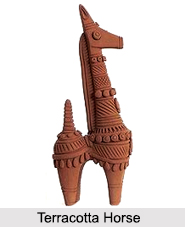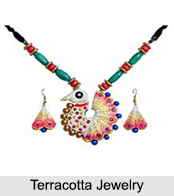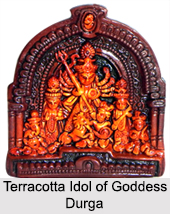 Coloured terracotta dolls are an exquisite form of folk art of West Bengal. The painters" community of Bengal"s villages dedicated themselves in painting and making these terracotta dolls. The dolls are made extremely attractive with distinct face, eyes, limbs, postures and bright colours and dresses. Terracotta dolls are made either with the help of moulds or by shaping soft clay with fingers. The terracotta dolls are generally light in weight and they are sold in the village fairs.
Coloured terracotta dolls are an exquisite form of folk art of West Bengal. The painters" community of Bengal"s villages dedicated themselves in painting and making these terracotta dolls. The dolls are made extremely attractive with distinct face, eyes, limbs, postures and bright colours and dresses. Terracotta dolls are made either with the help of moulds or by shaping soft clay with fingers. The terracotta dolls are generally light in weight and they are sold in the village fairs.
Types of Coloured Terracotta Dolls
The terracotta dolls are classified with some comical names such as shilet dolls, hingli dolls, mask dolls, big dolls, jhum-jhumi dolls etc. Shilet dolls are hung on the walls like plaques. Hingli dolls are made by shaping the soft clay with fingers. Mask dolls are basically in the shape of a mask which mostly varies in size. Big dolls are generally made of two shells and they vary from 10 to 25 cm in height. A special type of hingli doll is produced in some parts of West Bengal; the dolls are in shape of women carrying a baby in her arm with a hand on her waist. This type of hingli dolls are the most remarkable ones.
 Some other types of terracotta objects are fish, ranging from the rui to the lobster, cat, tiger, elephant, cow, peacock, horses, parrot, a pair of birds perched on a rod, a housewife carrying a pitcher of water, combined masks of man and woman, masks of Gods and Goddesses, like Radha and Krishna, Lakshmi, Saraswati, Shasthi, Shiva, Durga and Kali, a hermit, a head-priest, jewelry etc.
Some other types of terracotta objects are fish, ranging from the rui to the lobster, cat, tiger, elephant, cow, peacock, horses, parrot, a pair of birds perched on a rod, a housewife carrying a pitcher of water, combined masks of man and woman, masks of Gods and Goddesses, like Radha and Krishna, Lakshmi, Saraswati, Shasthi, Shiva, Durga and Kali, a hermit, a head-priest, jewelry etc.
Procedure of Making Terracotta Dolls
First, a thin disk of clay is put into a mould to get the desired form for the doll. After getting the shapes from the mould, they are all joined together and dried up and then burnt in fire. The colour for the painting on the dolls is generally prepared before with the help of the age old process. Lampblack, blue and green vitriol, mud-coloured vermilion, soft clay, red ochre, chalk and lac-dye are used to prepare the colour. In modern days, artisans of these dolls use chemical paints, which are easily available in the market. A paste of tamarind seeds or the glue of marmelos or margosa is applied for making the colour stick to the body of the doll.
 Artisans of Coloured Terracotta Dolls
Artisans of Coloured Terracotta Dolls
Mostly, the artisans of these terracotta dolls are from the districts of Medinipur and Howrah. In Medinipur, the painters of Narhajol are the most popular ones for making these dolls. Apart from Narhajol, painters of Nirbhoypur, Siuri, Keshabbarh, Chaitanyapur, Naya, Golgram, Hobibachak, Muradpur and Madpur of the same district have also been producing terracotta dolls since ages. The painters` communities of Chandipur, Liluah and Prashastha villages of Howrah District are also popular for their artistry in making terracotta dolls. The painters of Puinan, Talchinan and Morha villages of Hooghly District, Akhrapunji and Kankanberhe of South 24 Parganas District and some villages of Birbhum District are still occupied in making these dolls.



















